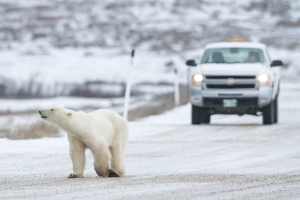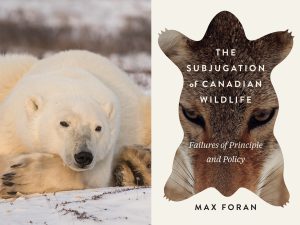Seven-year-old Nanurjuk, “the bear-spirited one,” is hunting for seals on Hudson Bay in Canada’s Arctic on a frosty day in February. The temperature on the ice is −37ºC. The temperature of the blood circulating through arteries and veins of her massive feet is around +37ºC. Exposed human flesh at this temperature freezes in minutes. And yet in the half inch between the surface of the snow and the inside of her feet, there is a temperature difference of 74 degrees.
The polar bear, as all bears do, steps forward onto her heels, leaving full round footprints wherever she goes. A bigger foot area produces a snowshoe effect in deep snow, exerting less pressure on thin ice. Her hind feet step perfectly into the prints of her front feet, saving the energy she would need to expend to break track with all four feet in deep snow. The impression she leaves on this trail she’s making is that she is on just two legs, upright like a woman.
She sniffs the frigid air, with almost no vapor trail from her mouth or nose. In a frozen world where liquid freshwater for drinking is absent, she draws on metabolic water created by the burning of seal fat, her main food source, and thus, is able to conserve moisture and stay sufficiently hydrated, when a human would soon die from winter dehydration. Every one of these adaptations is a marvel that has taken untold generations to evolve. These are not physiological changes that can respond to seasonal or even annual environmental shifts.
In her first winter, as she was learning about the ice and the hunt with her mother, Nanu experienced a stillness of winter ice she has not seen since. Back then, seven years ago, the bay surface froze thick and deep. When the temperature would rise or fall by a few degrees, enough to make the ice expand or contract, the peace would be broken with cannon booms of cracks forming. Otherwise, her world was silent.
On this late February day, the ice is talkative, moved by wind and current and murmuring constantly with voices that sound old and crotchety at one moment, young and squeaky at another, like summer gulls. Pressure ridges form along the cracks, rising like mini mountain ranges and snaking toward the sky. At other times, the grinding of ice on ice creates keels that push down into the water, inverted mountain ranges that are rich habitats for plankton, krill, fish and ultimately seals, who make their way into Nanu’s diet—when she gets lucky.
The active ice makes it difficult to discern what might be a seal and what might be just moving ice. But visual cues are only part of the hunt. With the sensitivity of those amazing feet, she can feel vibrations. Sometimes, these are from the movement of the ice itself, other times, from seals scratching and scraping as they tend their breathing holes. She can also sense the subtlest of movements with her ears. And there is always the smell of seal. Today, without question, there is seal on the wind.
Experience has taught Nanu that seals are formidable in their ability to avoid capture. They, too, can differentiate sounds underwater almost as well as they do in air. So Nanu takes care to ensure that she gets the upper hand. Despite her considerable size and mass, she places each foot deliberately to avoid percussive pressure on the ice or any cracking of surface crystals, which might betray her intentions to nearby prey.
She stops between two bus-sized chunks of ice and lets her belly rest on the cool surface beside an almost imperceptible dome in the surface of the new snow. This is an aglu, a breathing hole for seals. The seal smell has been getting stronger as she draws closer to this exact point. She waits for the familiar compression of air when the seal’s face breaks the surface of the water in the aglu.
She listens. Nothing. There is a faint smell of blood, a good sign. Again she waits, at the air hole, completely still.
At last, her whiskers sense the sonic puff of air. Slowly, reflexively, she coils herself back onto her haunches, pulling her hind legs under her and allowing her forelegs to extend so that her massive shoulders and chest are as high off the snow as possible. And then, in an explosion of energy, cold air, and flying snow, she rises up and crashes down, punching through the new snow and the crusted dome of the lair onto the unsuspecting seal. She can feel her grasping claws sink into its soft belly as it turns to dive back into the safety of the water, and then with strength and precision, she plunges her head through the hole, her teeth crushing the soft skull of the seal, killing it instantly.
Nanu flings it out onto the surface of the ice, where blood belches into the new snow. Wasting no time, she rolls her warm prize onto its side and, with razor-sharp incisors, cuts back the drying gray pelt, devouring mouthfuls of blubber as she flenses all of the available fat from both the skin and the musculature of the seal. Already its smell is telegraphing across the ice. She must eat before anyone else decides to join the feast.
Overhead, the sun moves higher in the sky, and with each passing day, its heat and the general warming of the atmosphere will start to soften and break up the ice. The heart of North America is alive and readying to contract and flush out this year’s fractured ice through Hudson Strait and into global oceanic circulation, where, as the ice moves into warmer waters, it will eventually disintegrate. Farther north, where multiyear ice still exists, things are less transient. But here on Hudson Bay, where ice never lasts any longer than one season, everything is in flux. The ice is moving, literally, under Nanu’s feet.
Excerpted from Ice Walker: A Polar Bear’s Journey Through the Fragile Arctic, by James Raffan. Published by Simon and Schuster Canada. Copyright © 2020. All rights reserved.
James Raffan will be participating in the Jaipur Literature Festival, taking place from November 27-29, 2020. Get more info on the festival website.





